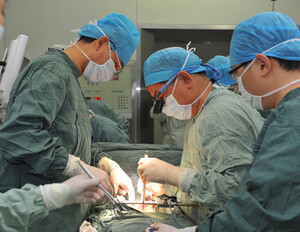- Adult Heart DiseaseDiseases of the arteries, valves, and aorta, as well as cardiac rhythm disturbances
- Pediatric and Congenital Heart DiseaseHeart abnormalities that are present at birth in children, as well as in adults
- Lung, Esophageal, and Other Chest DiseasesDiseases of the lung, esophagus, and chest wall
- ProceduresCommon surgical procedures of the heart, lungs, and esophagus
- Before, During, and After SurgeryHow to prepare for and recover from your surgery
March 25, 2019
Through the years, I’ve had patients come to me with facts, figures, and concerns that they have gathered from the internet or heard from friends and family. While I think it is essential for anyone dealing with a medical issue to collect information from a variety of reliable sources, I also have noticed that there are some common myths that tend to surface. I will debunk six of them here.
1. They take my heart out of my chest to perform the surgery.
It is a common misperception that your heart is taken out of your body during heart surgery. I am happy to confirm that this is not really true. The only heart surgery in which the heart is physically removed from the chest is heart transplantation. Most common heart procedures can even be completed with minimally invasive techniques, which means less scarring and faster recovery.

2. Heart surgery will cause a stroke or hurt my brain function.
Thankfully, this is far more unusual today than in the past. While old medical reports cite high occurrence of stroke and brain damage after open heart surgery, targeted improvements in surgical techniques have significantly reduced these risks. However, it is always best to discuss your specific medical condition with your doctor before surgery. Postoperative complications are always possible, but the particular risk of stroke and brain damage after open heart surgery is much lower than it used to be.
3. Robotic surgery is better.
Not necessarily. First, let’s understand what robotic surgery actually is. Robotic surgery is a minimally invasive surgery that uses very small cuts to enter the chest and tiny robotic tools to perform the procedures. While there are many benefits to robotic surgery, it is generally more expensive than minimally invasive surgery performed by a surgeon and is not required for equally good results.
4. I won’t be able to drive or resume normal activities for 6 weeks after surgery.
This is not true. While some healing goes on for a long time after surgery, you should be up walking around the day after and be resuming light activities by the time you go home 3 to 5 days later. We typically recommend at least 2 weeks before engaging in more involved activities like driving. The most important aspect of recovery from heart surgery is to be patient with yourself, understanding that it will take time for you to feel 100% back to your normal capacity. Keep in touch with your doctor and ask questions in the process to make sure you are on track.
5. Angioplasty is safer than bypass surgery.
Before we address this myth, let’s get a better understanding of what these two procedures entail.
Angioplasty is a minimally invasive procedure that opens arteries around the heart that have become blocked. To help blood to flow again, a tiny deflated balloon is inserted into the vessel and then inflated to open the passageway. Usually, a stent is placed during the procedure, which maintains the opening.
Coronary artery bypass grafting (CABG) surgery or bypass surgery is a procedure in which the surgeon takes a vessel from another part of the body (the chest or the leg) and then grafts it above and below the blocked artery. This allows blood to “bypass” the blockage and flow to the heart muscle.
While it is true that angioplasty has a quicker recovery and requires smaller incisions than bypass surgery, patients who initially only get angioplasty usually wind up needing more procedures down the line (often another angioplasty or a CABG). Therefore, in some cases, it may be better to do the CABG first.
From a safety standpoint, initial outcomes of angioplasty vs. bypass surgery are comparable. Well-known clinical trials such as the SYNTAX trial (2008) and the BEST trial (2015) give CABG a leg up for people at higher risk for more blockages or with other complications such as diabetes.
6. TAVR is better than valve surgery.
Again, let’s first get a basic understanding of these two procedures.
Transcatheter aortic valve replacement (TAVR) is a minimally invasive procedure in which a damaged heart valve is replaced by a valve from another part of the body (usually the femoral artery in the leg) using a catheter. In this procedure, the damaged valve is not removed. The new valve simply takes over the job of controlling blood flow. TAVR is a quick procedure with a relatively easy recovery.
In a valve surgery, a damaged valve is repaired or replaced using a mechanical valve, from an animal or one made from human heart tissue. Depending on the specific needs of the patient, there are several different types of valve surgeries available. Generally, valve surgery is more taxing than TAVR, but has a demonstrated history of safety, durability, and effectiveness over time.
Currently, TAVR is only recommended for intermediate- to high-risk patients, such as people over 80 years old or those with precluding medical conditions. For low-risk patients, valve surgery is currently considered a better choice due to its proven reliability and good results.
A few key trials are under way (PARTNERS 3 and CorValve Low Risk) to help support a movement to get TAVR approved for low-risk patients. At this point, though, valve surgery remains the gold standard for low-risk patients, with durability and long-term outcomes being the main factors in question for TAVR.
The opinions expressed in this article are those of the author and do not necessarily reflect the views of The Society of Thoracic Surgeons.

